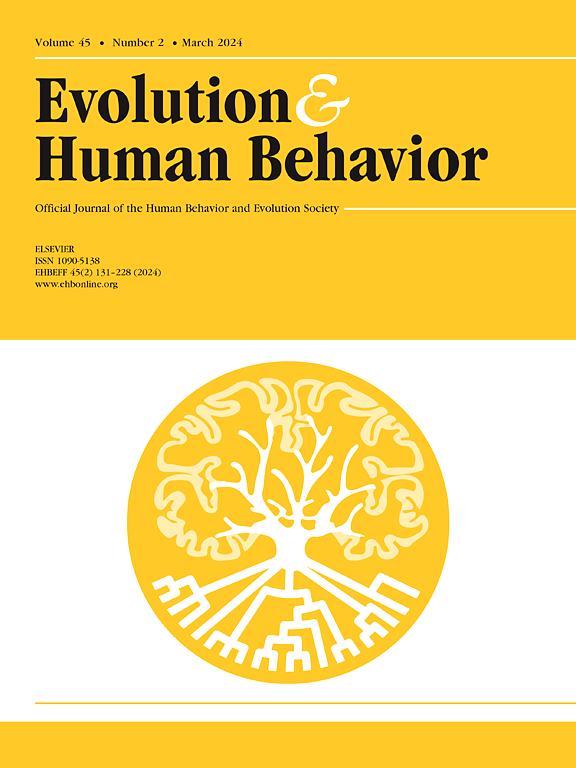病原体避免的烟雾探测器原理:行为免疫系统如何引起偏见的测试
IF 3.2
1区 心理学
Q1 BEHAVIORAL SCIENCES
引用次数: 0
摘要
避免传染病的动机似乎影响了对某些群体的偏见,包括与传染病没有明确联系的群体。对这一现象的标准解释是基于信号检测理论,并提出一些偏见部分源于病原体检测机制,这些机制倾向于制造假警报(假阳性),以尽量减少失误(假阴性)。因此,病原体检测机制可能会将一系列非典型特征分类为感染的指示性特征,从而对具有非典型特征的人产生负面影响。我们检验了从这一解释中得出的一个关键假设:在估计传染病存在时,基于特定外表的偏见与发出假警报的倾向有关。虽然这一假设隐含在许多关于行为免疫系统和偏见的工作中,但缺乏对其的直接测试,现有的相关工作也存在重要的局限性。为了验证这一假设,我们使用大量美国样本(N = 1450)进行了横断面研究。利用信号检测理论方法,我们评估了在识别感染威胁时产生假警报的倾向。我们进一步评估了对多个相关社会群体/类别的偏见。结果显示,关键假设的证据不足:在四个被测试的目标群体中,只有一个群体在疾病检测中产生假警报的倾向与偏见显著相关。然而,当控制潜在的混淆时,这种关系并不显著。这些结果使人们对基于外表的偏见的个体差异产生于评估病原体威胁时产生假警报倾向的个体差异这一概念产生了怀疑。本文章由计算机程序翻译,如有差异,请以英文原文为准。
The smoke-detector principle of pathogen avoidance: A test of how the behavioral immune system gives rise to prejudice
Motivations to avoid infectious disease seem to influence prejudice toward some groups, including groups not explicitly associated with infectious disease. The standard explanation for this phenomenon is based on signal detection theory and proposes that some prejudices partially arise from pathogen detection mechanisms that are biased toward making false alarms (false positives) in order to minimize misses (false negatives). Therefore, pathogen detection mechanisms arguably categorize a broad array of atypical features as indicative of infection, which gives rise to negative affect toward people with atypical features. We tested a key hypothesis derived from this explanation: specific appearance-based prejudices are associated with tendencies to make false alarms when estimating the presence of infectious disease. While this hypothesis is implicit in much work on the behavioral immune system and prejudice, direct tests of it are lacking and existing relevant work contains important limitations. To test the hypothesis, we conducted a cross-sectional study using a large U.S. sample (N = 1450). Using signal detection theory methods, we assessed tendencies to make false alarms when identifying infection threats. We further assessed prejudice toward multiple relevant social groups/categories. Results showed weak evidence for the key hypothesis: for only one of four tested target groups were tendencies to make false alarms in sickness detection significantly associated with prejudice. However, this relation was not significant when controlling for a potential confound. These results cast doubt on the notion that individual differences in appearance-based prejudices arise from individual differences in tendencies to make false alarms in assessing pathogen threats.
求助全文
通过发布文献求助,成功后即可免费获取论文全文。
去求助
来源期刊

Evolution and Human Behavior
生物-行为科学
CiteScore
8.30
自引率
9.80%
发文量
62
审稿时长
82 days
期刊介绍:
Evolution and Human Behavior is an interdisciplinary journal, presenting research reports and theory in which evolutionary perspectives are brought to bear on the study of human behavior. It is primarily a scientific journal, but submissions from scholars in the humanities are also encouraged. Papers reporting on theoretical and empirical work on other species will be welcome if their relevance to the human animal is apparent.
 求助内容:
求助内容: 应助结果提醒方式:
应助结果提醒方式:


